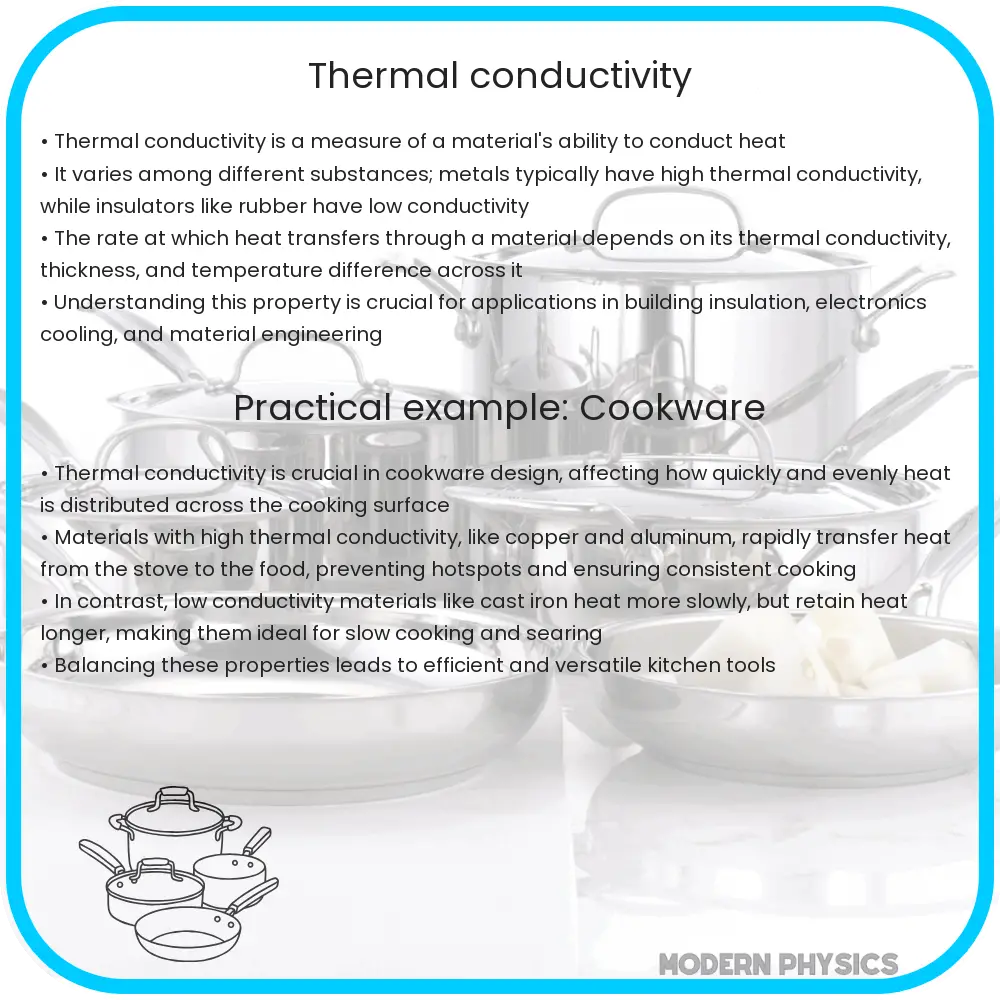Explore the essentials of thermal conductivity, its impact on heat transfer efficiency, and its diverse applications in technology and industry.

Understanding Thermal Conductivity: Efficiency, Transfer, and Applications
Thermal conductivity is a material property that describes the ability to conduct heat. It plays a crucial role in a wide range of applications, from industrial processes to everyday products. Understanding how thermal conductivity works, its efficiency, and its applications is essential for engineers, scientists, and anyone interested in heat transfer technologies.
What is Thermal Conductivity?
Thermal conductivity, denoted as k, is a measure of a material’s ability to conduct heat. It is defined as the amount of heat (Q) transferred through a material with thickness (d) over a given area (A) due to a temperature difference (ΔT) across the material. The mathematical expression is:
Q = k * A * (ΔT/d)
This formula highlights that higher thermal conductivity means more efficient heat transfer.
Factors Affecting Thermal Conductivity
Several factors influence thermal conductivity:
- Material Composition: Different materials have varying intrinsic abilities to conduct heat. Metals, for instance, typically have higher thermal conductivities than insulators like rubber or plastic.
- Temperature: For many materials, thermal conductivity changes with temperature. For example, metals usually conduct better at lower temperatures.
- Phase: The state of the material (solid, liquid, gas) can affect its thermal conductivity. Generally, solids have higher conductivity than liquids and gases.
- Impurities and Defects: The presence of impurities and defects can significantly alter a material’s thermal conductivity.
Efficiency of Heat Transfer
Efficiency in heat transfer is closely tied to thermal conductivity. Materials with high thermal conductivity are more efficient in transferring heat, making them ideal for applications like heat sinks in electronics or cooking utensils. Conversely, materials with low thermal conductivity are effective insulators, used in applications like thermal insulation in buildings or protective clothing.
Applications of Thermal Conductivity
Understanding and manipulating thermal conductivity is essential in various industries. Some key applications include:
- Electronics: Managing heat in electronic devices to prevent overheating and ensure efficient operation.
- Building Materials: Insulation materials are selected based on their low thermal conductivity to reduce energy loss.
- Manufacturing: In processes like welding and casting, controlling thermal conductivity is crucial for product quality.
Thermal conductivity is not just a fundamental material property; it’s a critical factor in designing and improving a multitude of products and processes. In the next section, we will explore specific examples and the future of thermal conductivity in technology and industry.
Advanced Applications and Future Trends in Thermal Conductivity
The scope of thermal conductivity extends beyond conventional uses, venturing into innovative fields and future technologies. Cutting-edge applications are reshaping industries, offering new solutions and challenging existing paradigms.
Nanotechnology and Thermal Management
In the realm of nanotechnology, thermal conductivity plays a pivotal role. Nanostructured materials, like graphene, demonstrate exceptional heat transfer capabilities. These materials are revolutionizing thermal management in microelectronics, where efficient heat dissipation is crucial for maintaining performance and longevity.
Thermoelectric Materials
Another exciting development is in thermoelectric materials, which convert heat into electricity and vice versa. These materials, exploiting the Seebeck and Peltier effects, are essential for power generation and refrigeration applications, offering a sustainable alternative to traditional methods.
Aerospace Applications
In the aerospace sector, thermal conductivity is critical for both insulating spacecraft from extreme temperatures and protecting components from the intense heat generated during re-entry into the Earth’s atmosphere. Advanced ceramics and composite materials are being developed to meet these challenging demands.
Challenges and Future Directions
Despite the advances, challenges remain. Balancing high thermal conductivity with other material properties, like electrical insulation or mechanical strength, is a continuous pursuit. Research is also focused on developing cost-effective, environmentally friendly materials with tailored thermal properties.
The future of thermal conductivity lies in material innovation and smart design. With ongoing research in areas like metamaterials and molecular engineering, the next generation of materials promises even more efficient heat management solutions.
Conclusion
Thermal conductivity is a fundamental property that impacts a wide array of applications, from daily household items to sophisticated aerospace technology. Its role in efficient heat transfer makes it a cornerstone in material science and engineering. As we advance, the continued exploration and understanding of thermal conductivity will lead to more innovative applications, enhancing the efficiency, safety, and sustainability of technologies that shape our world. The journey of thermal conductivity, from a basic physical concept to a pillar of modern engineering and technology, highlights the endless possibilities that await in the realm of material science.
